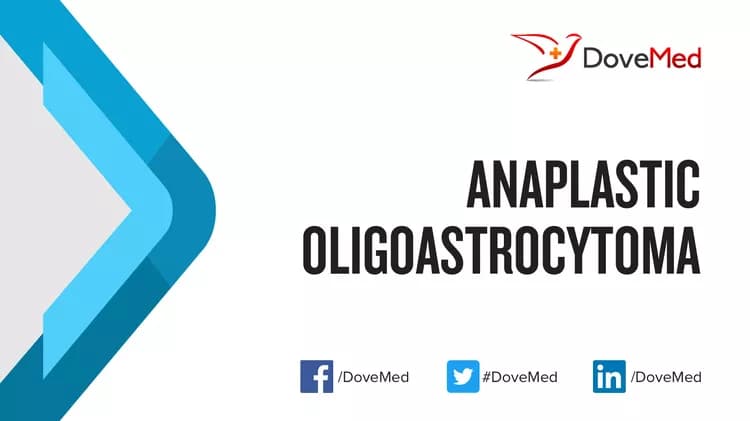What are the other Names for this Condition? (Also known as/Synonyms)
- aMOA
What is Anaplastic Oligoastrocytoma? (Definition/Background Information)
- Anaplastic Oligoastrocytoma is a brain tumor that forms when two types of cells in the brain, called oligodendrocytes and astrocytes, rapidly increase in number to form a mass
- These brain cells are known as glial cells, which normally protect and support nerve cells in the brain. Because an oligoastrocytoma is made up of a combination of two cell types, it is known as a mixed glioma
- An oligoastrocytoma is described as anaplastic when the tumor grows quickly and the cancer cells within the tumor have the potential to spread into surrounding brain tissue or to more distant parts of the body
- Oligoastrocytomas usually occur in a part of the brain called the cerebrum and are diagnosed in adults between the ages of 30 and 50 years
- The exact cause of this condition is unknown
(Source: Anaplastic Oligoastrocytoma; Genetic and Rare Diseases Information Center (GARD) of National Center for Advancing Translational Sciences (NCATS), USA.)
Who gets Anaplastic Oligoastrocytoma? (Age and Sex Distribution)
- Anaplastic Oligoastrocytoma is a rare form of brain tumor. The presentation of symptoms typically occurs in young and middle-aged adults (in the 30-50 years’ age group)
- Both males and females may be affected
- Worldwide, individuals of all racial and ethnic groups may be affected
What are the Risk Factors for Anaplastic Oligoastrocytoma? (Predisposing Factors)
- Currently, no risk factors have been clearly identified for Anaplastic Oligoastrocytoma
It is important to note that having a risk factor does not mean that one will get the condition. A risk factor increases one’s chances of getting a condition compared to an individual without the risk factors. Some risk factors are more important than others.
Also, not having a risk factor does not mean that an individual will not get the condition. It is always important to discuss the effect of risk factors with your healthcare provider.
What are the Causes of Anaplastic Oligoastrocytoma? (Etiology)
The cause of formation of Anaplastic Oligoastrocytoma is presently not well-understood.
What are the Signs and Symptoms of Anaplastic Oligoastrocytoma?
The signs and symptoms of Anaplastic Oligoastrocytoma may depend on the size of the tumor and its exact location in the brain. The most common symptoms include:
- Headaches
- Seizures
- Changes in personality
(Source: Anaplastic Oligoastrocytoma; Genetic and Rare Diseases Information Center (GARD) of National Center for Advancing Translational Sciences (NCATS), USA.)
How is Anaplastic Oligoastrocytoma Diagnosed?
Anaplastic Oligoastrocytoma is diagnosed on the basis of the following information:
- Complete physical examination
- Thorough medical history evaluation
- Assessment of signs and symptoms
- Laboratory tests
- Imaging studies
- Biopsy studies, if necessary
Many clinical conditions may have similar signs and symptoms. Your healthcare provider may perform additional tests to rule out other clinical conditions to arrive at a definitive diagnosis.
What are the possible Complications of Anaplastic Oligoastrocytoma?
The complications of Anaplastic Oligoastrocytoma may include:
- Risk of fall and injury due to seizures
- Reduced social interactions due to behavioral changes
- Metastasis of tumor to local and distant regions
Complications may occur with or without treatment, and in some cases, due to treatment also.
How is Anaplastic Oligoastrocytoma Treated?
The treatment of Anaplastic Oligoastrocytoma depends on the size and location of the tumor.
- If possible, treatment begins with surgery to remove as much of the tumor as possible
- Chemotherapy or radiation therapy may be needed following surgery to destroy any remaining cancer cells
(Source: Anaplastic Oligoastrocytoma; Genetic and Rare Diseases Information Center (GARD) of National Center for Advancing Translational Sciences (NCATS), USA.)
How can Anaplastic Oligoastrocytoma be Prevented?
- The exact cause or risk factors for Anaplastic Oligoastrocytoma are not known. Therefore, currently, no guidelines or methods are available towards preventing tumor formation
- Active research is currently being performed to explore the possibilities for treatment and prevention of tumors such as Anaplastic Oligoastrocytoma
- Regular medical screening at periodic intervals with tests and physical examinations are highly recommended
What is the Prognosis of Anaplastic Oligoastrocytoma? (Outcomes/Resolutions)
- Anaplastic Oligoastrocytoma often develops in the cerebral hemispheres of the brain; in many, the prognosis is guarded
- Regular follow-up visits with the healthcare provider are important once a diagnosis is made
- Typically, the prognosis may be assessed on a case-by-case basis
Additional and Relevant Useful Information for Anaplastic Oligoastrocytoma:
The following DoveMed website link is a useful resource for additional information:
Related Articles
Test Your Knowledge
Asked by users
Related Centers
Related Specialties
Related Physicians
Related Procedures
Related Resources
Join DoveHubs
and connect with fellow professionals


0 Comments
Please log in to post a comment.